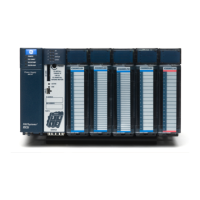Chapter 4. Ladder Diagram (LD) Programming
GFK-2950C February 2018 217
4.13.2 Timer Function Blocks
Built-in
(instance data is
WORD array)
See Built-In Timer
Function Blocks
below.
OFDT_HUNDS
OFDT_SEC
OFDT_TENTHS
OFDT_THOUS
The Current Value (CV) of the timer resets to zero
when power flow input is on. CV increments while
power flow is off. When CV=PV (Preset Value),
power flow is no longer passed to the right until
power flow input is on again.
ONDTR_HUNDS
ONDTR_SEC
ONDTR_TENTHS
ONDTR_THOUS
Retentive on delay timer. Increments while it
receives power flow and holds its value when
power flow stops.
TMR_HUNDS
TMR_SEC
TMR_TENTHS
TMR_THOUS
Simple on delay timer. Increments while it
receives power flow and resets to zero when
power flow stops.
Standard
(instance data is a
structure variable)
See Standard Timer
Function Blocks.
When the input IN transitions from ON to OFF,
the timer starts timing until a specified period of
time has elapsed, then sets the output Q to OFF.
When the input IN transitions from OFF to ON,
the timer starts timing until a specified period of
time has elapsed, then sets the output Q to ON.
When the input IN transitions from OFF to ON,
the timer sets the output Q to ON for a specified
time interval.
Built-In Timer Function Blocks
Note: Special care must be taken when programming timers in program blocks that are not called
every sweep, and in parameterized blocks and UDFBs. For details, refer to:
- Using OFDT, ONDTR and TMR in Program Blocks not Called Every Sweep
- Timers that are Skipped by the Jump Instruction
- Using OFDT, ONDTR and TMR in Parameterized Blocks, and
- Using OFDT, ONDTR and TMR in UDFBs.
Data Required for Built-in Timer Function Blocks
The data associated with these functions is retentive through power cycles. Each timer uses a three-
word array of %R, %W, %P, %L or symbolic memory to store the following information:

